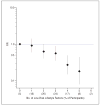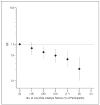Lifestyle risk factors and new-onset diabetes mellitus in older adults: the cardiovascular health study
- PMID: 19398692
- PMCID: PMC2828342
- DOI: 10.1001/archinternmed.2009.21
Lifestyle risk factors and new-onset diabetes mellitus in older adults: the cardiovascular health study
Abstract
Background: The combined impact of lifestyle factors on incidence of diabetes mellitus later in life is not well established. The objective of this study was to determine how lifestyle factors, assessed in combination, relate to new-onset diabetes in a broad and relatively unselected population of older adults.
Methods: We prospectively examined associations of lifestyle factors, measured using repeated assessments later in life, with incident diabetes mellitus during a 10-year period (1989-1998) among 4883 men and women 65 years or older (mean [SD] age at baseline, 73 [6] years) enrolled in the Cardiovascular Health Study. Low-risk lifestyle groups were defined by physical activity level (leisure-time activity and walking pace) above the median; dietary score (higher fiber intake and polyunsaturated to saturated fat ratio, lower trans-fat intake and lower mean glycemic index) in the top 2 quintiles; never smoked or former smoker more than 20 years ago or for fewer than 5 pack-years; alcohol use (predominantly light or moderate); body mass index less than 25 (calculated as weight in kilograms divided by height in meters squared); and waist circumference of 88 cm for women or 92 cm for men. The main outcome measure was incident diabetes defined annually by new use of insulin or oral hypoglycemic medications. We also evaluated fasting and 2-hour postchallenge glucose levels.
Results: During 34,539 person-years, 337 new cases of drug-treated diabetes mellitus occurred (9.8 per 1000 person-years). After adjustment for age, sex, race, educational level, and annual income, each lifestyle factor was independently associated with incident diabetes. Overall, the rate of incident diabetes was 35% lower (relative risk, 0.65; 95% confidence interval, 0.59-0.71) for each 1 additional lifestyle factor in the low-risk group. Participants whose physical activity level and dietary, smoking, and alcohol habits were all in the low-risk group had an 82% lower incidence of diabetes (relative risk, 0.18; 95% confidence interval, 0.06-0.56) compared with all other participants. When absence of adiposity (either body mass index <25 or waist circumference < or =88/92 cm for women/men) was added to the other 4 low-risk lifestyle factors, incidence of diabetes was 89% lower (relative risk, 0.11; 95% confidence interval, 0.01-0.76). Overall, 9 of 10 new cases of diabetes appeared to be attributable to these 5 lifestyle factors. Associations were slightly attenuated, but still highly significant, for incident diabetes defined by medication use or glucose level.
Conclusion: Even later in life, combined lifestyle factors are associated with a markedly lower incidence of new-onset diabetes mellitus.
Figures



References
-
- Tuomilehto J, Lindstrom J, Eriksson JG, et al. Finnish Diabetes Prevention Study Group. Prevention of type 2 diabetes mellitus by changes in lifestyle among subjects with impaired glucose tolerance. N Engl J Med. 2001;344(18):1343–1350. - PubMed
-
- Helmrich SP, Ragland DR, Leung RW, Paffenbarger RS., Jr Physical activity and reduced occurrence of non–insulin-dependent diabetes mellitus. N Engl J Med. 1991;325(3):147–152. - PubMed
-
- Lynch J, Helmrich SP, Lakka TA, et al. Moderately intense physical activities and high levels of cardiorespiratory fitness reduce the risk of non–insulin-dependent diabetes mellitus in middle-aged men. Arch Intern Med. 1996;156 (12):1307–1314. - PubMed
Publication types
MeSH terms
Grants and funding
- K08 HL075628/HL/NHLBI NIH HHS/United States
- N01-HC-85085/HC/NHLBI NIH HHS/United States
- N01-HC-85081/HC/NHLBI NIH HHS/United States
- N01-HC-85086/HC/NHLBI NIH HHS/United States
- N01-HC-85082/HC/NHLBI NIH HHS/United States
- N01 HC-55222/HC/NHLBI NIH HHS/United States
- N01 HC055222/HL/NHLBI NIH HHS/United States
- K01 HL070444/HL/NHLBI NIH HHS/United States
- N01-HC-85079/HC/NHLBI NIH HHS/United States
- N01 HC075150/HL/NHLBI NIH HHS/United States
- N01 HC045133/HC/NHLBI NIH HHS/United States
- N01 HC035129/HC/NHLBI NIH HHS/United States
- N01-HC-85084/HC/NHLBI NIH HHS/United States
- K01-HL-70444/HL/NHLBI NIH HHS/United States
- U01 HL080295/HL/NHLBI NIH HHS/United States
- N01 HC015103/HC/NHLBI NIH HHS/United States
- N01 HC085086/HL/NHLBI NIH HHS/United States
- N01 HC085079/HL/NHLBI NIH HHS/United States
- N01-HC-85083/HC/NHLBI NIH HHS/United States
- N01-HC-75150/HC/NHLBI NIH HHS/United States
- N01-HC-85080/HC/NHLBI NIH HHS/United States
- K08-HL-075628/HL/NHLBI NIH HHS/United States
LinkOut - more resources
Full Text Sources
Medical

